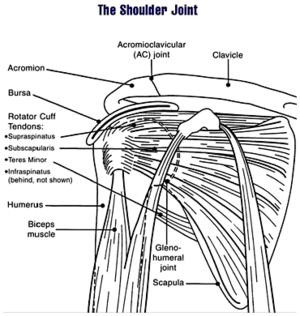
Image via Wikipedia
A Free Body Diagram is a pictorial representation often used by physicists and engineers to analyze the forces acting on a free body. A free body diagram shows all contact and non-contact forces acting on the body. Drawing such a diagram can aid in solving for the unknown forces or the equations of motion of the body. Creating a free body diagram can make it easier to understand the forces, and moments, in relation to one another and suggest the proper concepts to apply in order to find the solution to a problem. The diagrams are also used as a conceptual device to help identify the internal forces, (for example shear forces and bending moments in beams), which are developed within structures

Image via Wikipedia
Joint replacement involves surgery to replace the ends of bones in a damaged joint. This surgery creates new joint surfaces.
In shoulder replacement surgery, doctors replace the ends of the damaged upper arm bone (humerus) and usually the shoulder bone (scapula) or cap them with artificial surfaces lined with plastic or metal and plastic. Shoulder joint components may be held in place with cement, or they may be made with material that allows new bone to grow into the joint component over time to hold it in place without cement.

Image via Wikipedia
JOINT REPLACEMENT SURGERY
Joint replacement is one of the most common and successful operations in modern orthopaedic surgery. It consists of replacing painful, arthritic, worn or diseased parts of the joint with artificial surfaces shaped in such a way as to allow joint movement.
Arthroplasty is a common but loose term for joint replacement. Other types of surgery are also arthroplasties. Other common and valid synonyms are total joint replacement, total joint arthroplasty, joint resurfacing and artificial joint surgery.
Technique
This is a preview of SHORT NOTES ON JOINT REPLACEMENT SURGERY-BIOMECHANICS NOTES.
Read the full post (831 words, 2 images, estimated 3:19 mins reading time)




